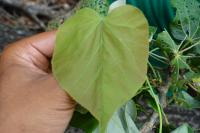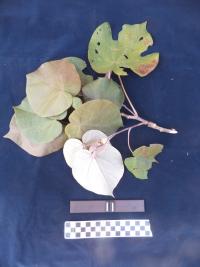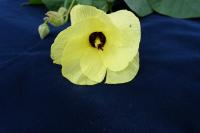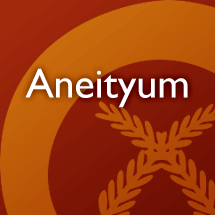Your search for * has returned 3 entries
inhau amai

n. moderately branched treelet, 2 m tall (collection: Gregory M. Plunkett #3203)
Example: 1a. This type of hibiscus has young leaves that are reddish in color and it is an edible type. The stems are eaten during April-July. Harvest the stems, beat them and cut off the outer bark. Collect inner bark, slicing it off the stem and wrapping it in a banana type leaf with coconut milk added. Bake all night at least 8 hours, then it is eaten. Said to taste like a root vegetable. Used during the dry season when there are not many crops available. 1b. Take young shoot of the tree then pound the base to separate the base of the bark from the stem but leave it on the stem, say pound 4-5 inches around the base, then come back 3-4 months and the rest of the bark would be thicker. Then cut where it was pounded, cut stem in 1.5-foot pieces, bake on an earth oven, leaves on bottom layer (on top of charcoal) then sticks, then leaves on top, then hot stones, and then more leaves. Bake for 1.5 hours, then remove a stick at a time and use shell to scrape away outer bark, cut into 6 inch pieces, put on log, pound to make softer, put in lap lap leaves leaf wrapping, add coconut milk, put in stone oven, cook for one hour then open lap lap leaves and eat. 2. This variety is for this purpose just like Pohnpei. 3. This variety is not used for grass skirt.
bookmarkinhau cap̃

n. low tree. Found along the coast. (collection: Ashley A McGuigan #11)
Example: 1. To speed up delivery and reduce painin labor - Take a piece of stem from a small branch and take the skin and outter bark off. Grate out the inner part with water and squeeze out juice into a cup for the woman to drink. 2. To help with pain/difficulty giving birth - Take even numbers of inhoa top leaves (Must have a partner so the lone top is not vulnerable to bad spirits - in all Rosita’s medicines, she always uses partners like this). Using 2, 4, or 6, of these leaves chew them and swallow the whole thing. This is slippery. Take at the first pain.
bookmarkintop̃ hau

n. well branched tree, 6 m tall (collection: Gregory M. Plunkett #3202)
Example: 1. Young shoots are peeled and made into grass skirts. Scrape the stem and take the green part off, tie strips together and put under stones in the sea for retting, let sit 5 days in sea, but check these on a daily basis. When the fiber becomes soft, that is the time to take it from under the stones, clean off the excess materials, and hang it in the sun to dry for 3 days--this will bleach it and give it a whitish color, at which point it can be woven into a skirt. 2. The fiber can be used to make a small rope that is tied with shells and used for custom dances. 3. When the stems of this tree are older, the wood is very hard and it can be used to make the main frame that is arched for a cyclone house. According to Reuben these houses are not made much anymore on Aneityum Island. 4. To cook the intestines of fish that are eaten, take several leaves and put them in a small pile, making a wrapping, then use a local fiber to tie this together and cook on charcoal for as long as needed to prepare the fish parts. 5. In this area, sometimes knowledge of the plants and flowering are used as a calendar to indicate the time for planting of specific crops. Reuben will provide more details on a future trip. 6a. This species is an important "message plant." If a person is not home and you are visiting from the East--e.g. an Eastern part of the Island--that person can leave a 12 inch piece of stick in front of the door of the house so that the inhabitant knows that an eastern visitor (from Anawonjei district) has come by your home. The reason that person has come to visit is to pass an important message to you--good or bad "luck". The bad luck message might be a death, and is not told directly to the person. The good luck message might be a birth, or conflict that has been resolved. These messages are communicated using sticks--each district has a different species of plant. Reuben’s is the hibiscus. 6b. Message plant for Eastern people. If someone dies, use this plant, clip it in front of hem, in front of home, they ask “who” and you can tell them. In Eastern culture you cannot tell them directly. 7. When a person is too drunk with kava, take a branch of this and brush him with it to help make the effects go away. 8. Traditional plates for food.
bookmark


